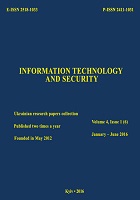Minimization measurement requirements for maintenance and repair special communication means
DOI:
https://doi.org/10.20535/2411-1031.2017.5.1.120586Keywords:
Special communication means, metrological service, maintenance, metrological characteristics, measuring instruments.Abstract
In the article describes the approach of determining the minimum required value of probability of a correct assessment of the measurement results for conventional algorithm arbitrary shape. Notice that the sequence and order of measurement parameters during metrological or maintenance service of special communication means depends on the results of previous inspections and represented as a conventional algorithms. Conventional algorithms is used distinguished by type (binary, homogeneous, group) and forms (perfect, minimal, arbitrary, maximum). The flowchart algorithm for calculating the minimum required value of correct assessment probability of checking result while assessing technical state of the object on the conventional algorithm perfect shape is developed. The analytical value for assessing mathematical expectation of deviation from the true value of technical state is determined in the metrological or maintenance of special communication mean, that differ from the known high accuracy. The example of the application of the obtained results in the conventional algorithm determining the technical state of control subsystem operation of high power transmitter is shown. The obtained results in the article should be used in methodics of justification metrological characteristics of measuring instruments during the metrological examination at stages the design and development of new special communication means, as well as for metrology and maintenance service.
References
State Standard of Ukraine 2860-94 “Reliability engineering. Terms and Definitions”. Introduced from 1996.01.01, 90 p., 1996.
M.Y. Yakovlev and Y.V. Ryzhov “Approach to selection of military measurement means for metrological maintenance of military communication means”, Military-technical collection of the Army Academy, № 1(10), pp. 119–127, 2014.
L. Sakovych, V. Ryzhakov and V. Pavlov “Choice of measuring instruments for maintenance and current repair of information security systems equipment”, Law, normative and metrological systems of protection of information security in Ukraine, № 7, pp. 77–85, 2003.
S.P. Ksyonz, Diagnostics and maintainability of radio-electronic means. – M.: Radio and communication, 248 p., 1989.
M. Asprou. “The effect of instrument transformer accuracy class on the WLS state estimator accuracy” M. Asprou, E. Kyriakides, M. Albu, in Proc. IEEE Power and Energy Society General Meeting (PES), 25 November 2013, – pp. 1–5.
doi: 10.1109/PESMG.2013.6672666.
H. Czichos. “Handbook of Technical Diagnostics: Fundamentals and Application to Structures and Systems”. Springer, 566 p., 2013.
doi: 10.1007/978-3-642-25850-3; http://www.springer.com/gb/book/9783642258497.
Downloads
Published
How to Cite
Issue
Section
License
Copyright (c) 2020 Collection "Information technology and security"

This work is licensed under a Creative Commons Attribution 4.0 International License.
The authors that are published in this collection, agree to the following terms:
- The authors reserve the right to authorship of their work and pass the collection right of first publication this work is licensed under the Creative Commons Attribution License, which allows others to freely distribute the published work with the obligatory reference to the authors of the original work and the first publication of the work in this collection.
- The authors have the right to conclude an agreement on exclusive distribution of the work in the form in which it was published this anthology (for example, to place the work in a digital repository institution or to publish in the structure of the monograph), provided that references to the first publication of the work in this collection.
- Policy of the journal allows and encourages the placement of authors on the Internet (for example, in storage facilities or on personal web sites) the manuscript of the work, prior to the submission of the manuscript to the editor, and during its editorial processing, as it contributes to productive scientific discussion and positive effect on the efficiency and dynamics of citations of published work (see The Effect of Open Access).

